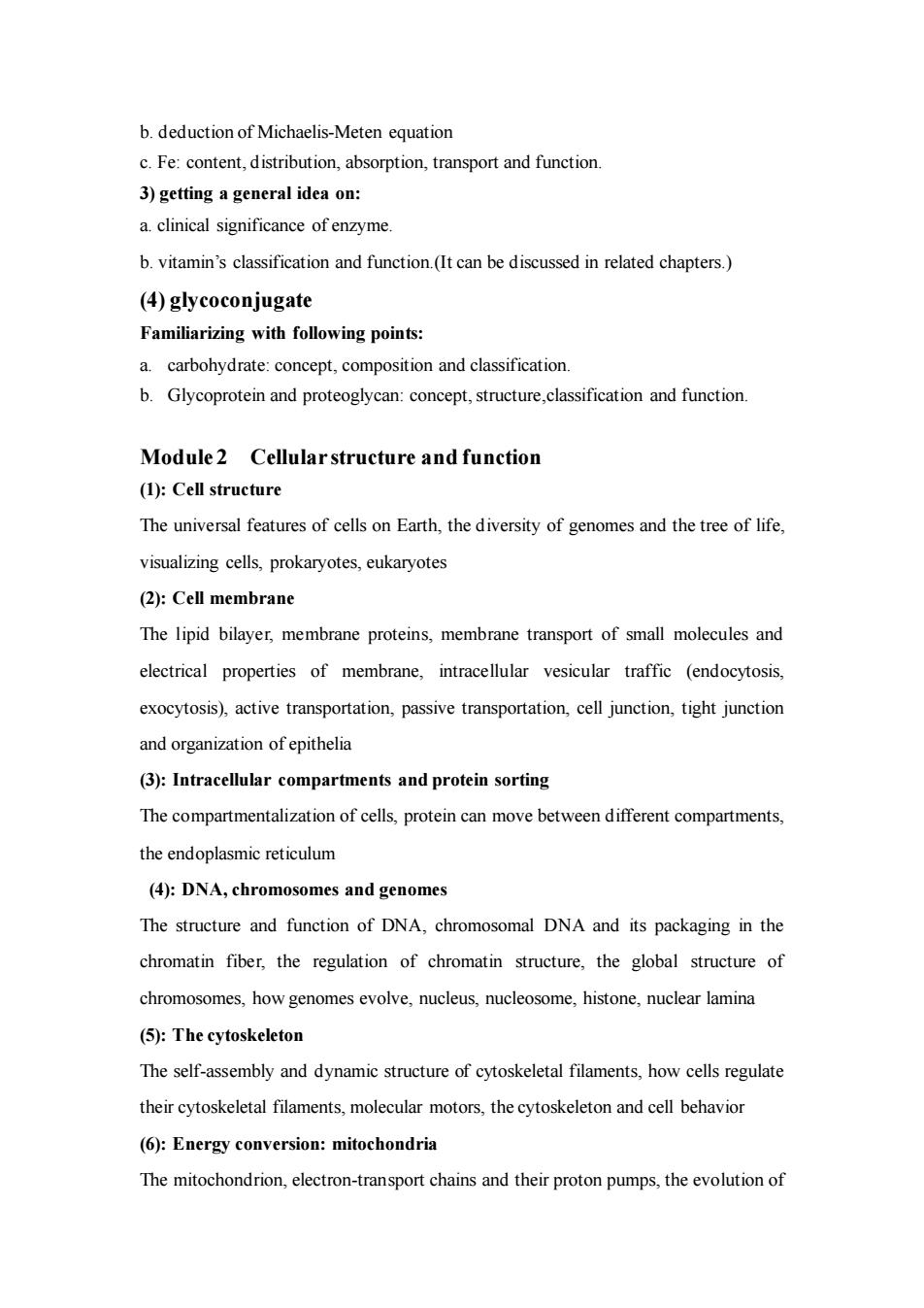正在加载图片...

b.deduction of Michaelis-Meten equation c.Fe:content,distribution,absorption,transport and function 3)getting a general idea on a.clinical significance of enzyme b.vitamin's classification and function.(It can be discussed in related chapters.) (4)glycoconjugate Familiarizing with following points: a.carbohydrate:concept,composition and classification. b.Glycoprotein and proteoglycan:concept,structure,classification and function Module2 Cellularstructure and function (1):Cell structure The universal features of cells on Earth,the diversity of genomes and the tree of life, visualizing cells,prokaryotes,eukaryotes (2):Cell membrane The lipid bilayer,membrane proteins,membrane transport of small molecules and electrical properties of membrane,intracellular vesicular traffic (endocytosis. exocytosis),active transportation,passive transportation,cell junction,tight junction and organization of epithelia (3):Intracellular compartments and protein sorting The compartmentalization of cells protein can move between different compartments. the endoplasmic reticulum (4):DNA,chromosomes and genomes The structure and function of DNA,chromosomal DNA and its packaging in the chromatin fiber,the regulation of chromatin structure.the global structure of chromosomes,how genomes evolve,nucleus,nucleosome,histone,nuclear lamina (⑤):The cytoskeleton The self-assembly and dynamic structure of cytoskeletal filaments,how cells regulate their cytoskeletal filaments,molecular motors,the cytoskeleton and cell behavior (⑥):Energy conversion:mitochondria The mitochondrion,electron-transport chains and their proton pumps,the evolution of b. deduction of Michaelis-Meten equation c. Fe: content, distribution, absorption, transport and function. 3) getting a general idea on: a. clinical significance of enzyme. b. vitamin’s classification and function.(It can be discussed in related chapters.) (4) glycoconjugate Familiarizing with following points: a. carbohydrate: concept, composition and classification. b. Glycoprotein and proteoglycan: concept, structure,classification and function. Module 2 Cellular structure and function (1): Cell structure The universal features of cells on Earth, the diversity of genomes and the tree of life, visualizing cells, prokaryotes, eukaryotes (2): Cell membrane The lipid bilayer, membrane proteins, membrane transport of small molecules and electrical properties of membrane, intracellular vesicular traffic (endocytosis, exocytosis), active transportation, passive transportation, cell junction, tight junction and organization of epithelia (3): Intracellular compartments and protein sorting The compartmentalization of cells, protein can move between different compartments, the endoplasmic reticulum (4): DNA, chromosomes and genomes The structure and function of DNA, chromosomal DNA and its packaging in the chromatin fiber, the regulation of chromatin structure, the global structure of chromosomes, how genomes evolve, nucleus, nucleosome, histone, nuclear lamina (5): The cytoskeleton The self-assembly and dynamic structure of cytoskeletal filaments, how cells regulate their cytoskeletal filaments, molecular motors, the cytoskeleton and cell behavior (6): Energy conversion: mitochondria The mitochondrion, electron-transport chains and their proton pumps, the evolution of